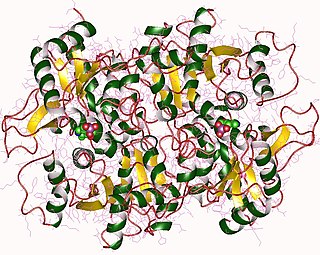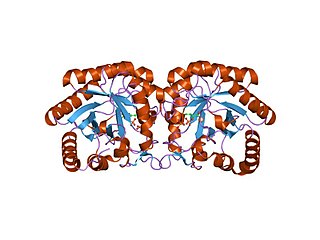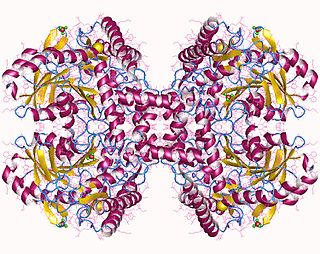
Pyridoxal phosphate (PLP, pyridoxal 5'-phosphate, P5P), the active form of vitamin B6, is a coenzyme in a variety of enzymatic reactions. The International Union of Biochemistry and Molecular Biology has catalogued more than 140 PLP-dependent activities, corresponding to ~4% of all classified activities. The versatility of PLP arises from its ability to covalently bind the substrate, and then to act as an electrophilic catalyst, thereby stabilizing different types of carbanionic reaction intermediates.
In molecular biology, biosynthesis is a multi-step, enzyme-catalyzed process where substrates are converted into more complex products in living organisms. In biosynthesis, simple compounds are modified, converted into other compounds, or joined to form macromolecules. This process often consists of metabolic pathways. Some of these biosynthetic pathways are located within a single cellular organelle, while others involve enzymes that are located within multiple cellular organelles. Examples of these biosynthetic pathways include the production of lipid membrane components and nucleotides. Biosynthesis is usually synonymous with anabolism.
The enzyme cysteine lyase catalyzes the chemical reaction
The enzyme phosphosulfolactate synthase catalyzes the reaction

The enzyme threonine synthase (EC 4.2.3.1) catalyzes the chemical reaction
The enzyme phosphoserine phosphatase (EC 3.1.3.3) catalyzes the reaction
In enzymology, a cysteine synthase is an enzyme that catalyzes the chemical reaction
In enzymology, an O-phosphoserine sulfhydrylase is an enzyme that catalyzes the chemical reaction
In enzymology, a dolichyl-phosphate beta-D-mannosyltransferase is an enzyme that catalyzes the chemical reaction
In enzymology, a CDP-diacylglycerol—serine O-phosphatidyltransferase is an enzyme that catalyzes the chemical reaction
In enzymology, a diphosphate-serine phosphotransferase is an enzyme that catalyzes the chemical reaction
In enzymology, a low-density-lipoprotein receptor kinase is an enzyme that catalyzes the chemical reaction
In enzymology, a serine-phosphoethanolamine synthase is an enzyme that catalyzes the chemical reaction

In enzymology, a tau-protein kinase is an enzyme that catalyzes the chemical reaction

3-Deoxy-D-arabinoheptulosonate 7-phosphate (DAHP) synthase is the first enzyme in a series of metabolic reactions known as the shikimate pathway, which is responsible for the biosynthesis of the amino acids phenylalanine, tyrosine, and tryptophan. Since it is the first enzyme in the shikimate pathway, it controls the amount of carbon entering the pathway. Enzyme inhibition is the primary method of regulating the amount of carbon entering the pathway. Forms of this enzyme differ between organisms, but can be considered DAHP synthase based upon the reaction that is catalyzed by this enzyme.
O-phospho-L-seryl-tRNA:Cys-tRNA synthase is an enzyme with systematic name O-phospho-L-seryl-tRNACys:hydrogen sulfide 2-aminopropanoate transferase. This enzyme catalyses the following chemical reaction
Phosphoserine transaminase is an enzyme with systematic name O-phospho-L-serine:2-oxoglutarate aminotransferase. This enzyme catalyses the following chemical reaction

O-phospho-L-seryl-tRNASec:L-selenocysteinyl-tRNA synthase is an enzyme with systematic name selenophosphate:O-phospho-L-seryl-tRNASec selenium transferase. This enzyme catalyses the following chemical reaction





